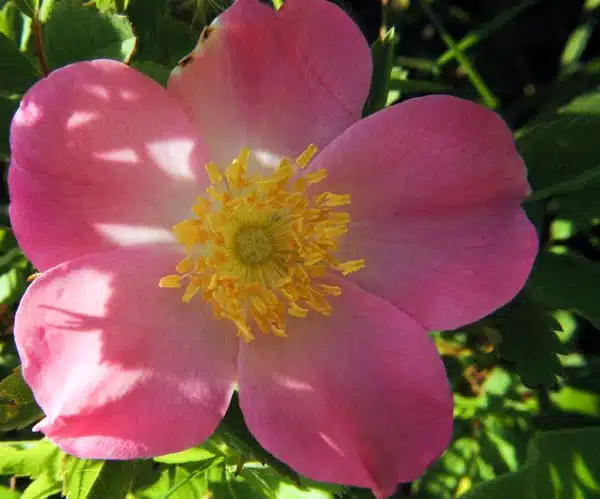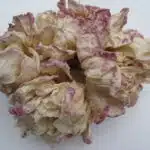Carolina rose, also known as Rosa carolina, is a beautiful and hardy species of rose that is native to the eastern United States. This perennial plant produces clusters of fragrant pink flowers from late spring to early summer, which are followed by bright red hips in the fall. Carolina rose is an excellent choice for gardeners who want to add some color and fragrance to their landscape while also supporting local wildlife.
Growing and caring for Carolina rose requires some knowledge and attention, but it is not overly difficult or time-consuming. This article will provide you with all the information you need to successfully cultivate this lovely plant in your garden. From selecting the right location and soil to pruning and pest control, we will guide you through each step of the process so that you can enjoy a healthy and thriving Carolina rose bush year after year. So let’s get started on this journey of discovery and learn how to grow and care for one of nature’s most beautiful gifts!
Understanding The Characteristics Of Carolina Rose
Carolina rose, commonly known by its scientific name Rosa carolina, is a deciduous shrub that belongs to the Rosaceae family. It is native to Eastern North America and can grow up to six feet tall. The plant has several characteristics that make it an attractive choice for gardeners. For one, Carolina rose boasts beautiful pink flowers that bloom in spring and summer. These flowers are followed by red hips that provide winter interest.
Carolina rose is relatively easy to care for and maintain. It thrives in well-drained soil and requires full sun exposure to bloom best. In terms of pest resistance assessment, Carolina rose is highly resistant to common pests such as aphids, spider mites, and Japanese beetles. However, it may occasionally fall prey to diseases such as black spot or powdery mildew.
Before planting your Carolina rose, it’s important to choose the right location for optimal growth and health. Ideally, you should select a spot with good air circulation and plenty of sunlight. Avoid planting your shrub near trees or other plants that may compete for nutrients or shade the plant excessively. Additionally, ensure that the soil is well-drained and rich in organic matter for best results.
Choosing The Right Location For Your Carolina Rose
Finding the perfect spot for your Carolina rose is crucial to ensure its optimal growth and bloom. The first thing you want to consider is sun exposure. Carolina roses love full sun, which means they need at least six hours of direct sunlight a day. When choosing a location, make sure there are no obstructions that block the sun’s rays.
The second factor to consider is soil pH. Carolina roses thrive in well-draining soil with a pH level between 6.0 and 6.5. You can test your soil’s pH level by using a soil testing kit, which can be purchased at most garden centers or online retailers. If your soil’s pH level is too high or too low, you can adjust it by adding lime or sulfur, respectively.
Wind protection and drainage are also essential factors to consider when choosing the right location for your Carolina rose. Roses do not like strong winds, as it can damage their delicate petals and leaves. Therefore, plant your Carolina rose in an area that provides some wind protection, such as near a wall or fence. Additionally, ensure that the planting site has adequate drainage to prevent waterlogging, as this can cause root rot and other fungal diseases.
Now that you have found the perfect location for your Carolina rose, it’s time to prepare the soil for optimal growth. By following specific steps to create nutrient-rich soil with proper drainage, you can give your Carolina rose everything it needs to grow big and beautiful!
Preparing The Soil For Optimal Growth
Soil preparation is crucial to the growth and health of any plant, and the Carolina Rose is no exception. Before planting your Carolina Rose, it’s essential to ensure that you have prepared the soil adequately. The first step in preparing soil for optimal growth is conducting a soil test.
Soil testing will help you determine the type of soil in which your Carolina Rose will grow best. The results of a soil test will provide valuable information on the nutrient levels, pH level, organic matter content, and texture of your soil. Once you know this information, you can make informed decisions about what amendments or fertilizers to add to your soil.
After conducting a soil test, it’s time to prepare the ground for planting. Start by removing any weeds or debris from the area where you plan to plant your Carolina Rose. Then loosen up the top four inches of soil with a garden fork or tiller. Add organic matter such as compost or aged manure to improve soil structure and fertility. Mix it into the top six inches of the loosened soil with a rake or hoe. Your Carolina Rose will thrive in well-draining and fertile soils that are rich in organic matter.
Now that you know how to prepare your soil optimally for growing Carolina Roses let’s move on to planting them!
Planting Your Carolina Rose
When it comes to planting your Carolina Rose, there are some essential tips that you should keep in mind. First and foremost, make sure that the area where you plan to plant the rose is well-drained, as waterlogging can be fatal to the plant. Additionally, Carolina Roses thrive in soils with a slightly acidic pH level between 5.5 and 6.5, so test your soil before planting to ensure that it meets these requirements.
When selecting a location for your Carolina Rose, choose an area with full sun exposure. This means at least six hours of direct sunlight each day. While Carolina Roses can tolerate some shade, they will not bloom as prolifically without adequate sunlight. Once you have selected the perfect spot for your rose, dig a hole twice as wide and just as deep as the root ball.
To further ensure that your Carolina Rose thrives after planting, it is important to pay attention to soil quality. Amend poor-quality soils by mixing in organic matter such as compost or well-rotted manure prior to planting. This will improve drainage and provide essential nutrients for your new plant’s growth.
Planting Tips:
- Choose a well-drained area with full sun exposure.
- Test soil pH levels before planting to ensure it meets requirements.
Soil Quality:
- Amend poor-quality soils by mixing in organic matter such as compost or well-rotted manure prior to planting.
Now that you have successfully planted your Carolina Rose in nutrient-rich soil and optimal light conditions, the next step is providing adequate water and nutrients for its growth and development.
Providing Adequate Water And Nutrients
After planting your Carolina Rose, you may think it’s smooth sailing from there. However, these roses require consistent care to thrive. One of the most important aspects of caring for your Carolina Rose is ensuring it has adequate water and nutrients. Without proper attention in this area, your plant will not flourish.
When it comes to watering your Carolina Rose, the key is consistency. The soil should be kept consistently moist but not overly saturated. During hot summer months, you may need to water more frequently to prevent the soil from drying out completely. As a general rule, aim for about an inch of water per week. This can come from rainfall or manual watering.
In addition to proper watering techniques, providing nutrient supplements is essential for your Carolina Rose’s growth and health. Fertilizers specifically formulated for roses can be applied every four to six weeks during the growing season (spring through fall). Be sure to follow package instructions carefully and avoid over-fertilization as this can damage the plant’s roots. With consistent care in watering and nutrient supplementation, your Carolina Rose will surely thrive and bring beauty to any garden space.
As with any plant, pruning and training play a crucial role in maintaining the shape and health of your Carolina Rose. In the next section, we’ll discuss how to properly prune and train your rose bush to promote healthy growth and abundant blooms. By following these steps diligently, you’ll be rewarded with a beautiful display of flowers year after year.
Pruning And Training Your Carolina Rose
Pruning techniques are important for maintaining the health and beauty of your Carolina rose. One of the most common methods is called deadheading, which is simply removing spent blooms. Deadheading promotes new growth and helps to prevent disease from spreading. Another technique is called thinning, which involves removing some of the older branches to promote better air circulation and sunlight penetration. Proper pruning will also help to shape the plant and control its size.
Training methods are also essential for a healthy Carolina rose bush. One popular method is trellising, where a structure is used to support the plant as it grows upward. This not only adds an attractive element to your garden but also helps prevent damage from high winds or heavy rain. Another option is staking, which involves using a stake or other support system to keep the plant upright as it grows.
It’s important to note that pruning and training should be done in late winter or early spring while the plant is still dormant. Avoid pruning during periods of active growth, as this can harm the plant and reduce its blooming potential. With proper care and attention, your Carolina rose will thrive for many years to come. Now that we’ve covered pruning and training techniques, let’s move on to identifying and treating common pests and diseases that may affect your plants.
Identifying And Treating Common Pests And Diseases
After successfully pruning and training your Carolina rose, it’s important to be aware of the pests and diseases that may threaten the health of your plant. In fact, it’s estimated that up to 30% of rose plants are lost each year due to these issues. It’s crucial to identify and treat any problems early on in order to ensure the longevity and beauty of your plant.
- Aphids, spider mites, thrips, and Japanese beetles are common pests that can cause damage to your Carolina rose.
- Fungal diseases such as black spot, powdery mildew, and rust can also impact the health of your plant.
- Prevention methods such as maintaining good air circulation around the plant and removing any diseased leaves or branches can help minimize risks.
- Natural remedies like neem oil or homemade garlic spray can also be effective in treating minor infestations.
If you do notice signs of pests or diseases on your Carolina rose, act quickly to minimize damage. Regularly inspecting your plant for any abnormalities is key in catching issues early on. Utilizing prevention methods and natural remedies can also help maintain the health of your plant without relying on harsh chemicals. By taking these steps, you can ensure a thriving and beautiful Carolina rose all year round.
As winter approaches, it’s important to take steps towards ensuring the survival of your Carolina rose during the colder months. While these plants are hardy enough to withstand some frost, extreme temperatures can cause damage or even kill them off entirely. In the next section, we’ll discuss effective ways to protect your Carolina rose from winter elements so you can enjoy its vibrant blooms for years to come.
Ensuring Winter Survival
Protective coverings and winter watering are essential to ensure the survival of Carolina Rose during the harsh winter season. One effective method is to cover the base of the plant with a layer of mulch, straw or leaves up to 4 inches deep. This will help retain moisture in the soil, prevent extreme temperature fluctuations and insulate roots from frost damage. Additionally, wrapping burlap around the plant can provide further protection against strong winds and snow buildup.
In colder regions, it is crucial to regularly water Carolina Rose during winter months. Although plants may be dormant, they still require moisture to survive. However, it is important not to overwater as this can lead to root rot. The best practice is to water once a month when temperatures are above freezing but below 40°F. It’s also important to avoid getting water on the foliage as this can cause damage from ice crystals forming on leaves.
By taking necessary precautions such as protective coverings and winter watering, you’ll give your Carolina Rose a better chance of surviving through the winter season. Come springtime, you’ll be rewarded with beautiful blooms that will make all your efforts worthwhile. Next up, we’ll discuss how you can propagate Carolina Rose so that you can expand your garden or share its beauty with others.
Propagating Carolina Rose
Propagating Carolina Rose from cuttings involves taking a cutting that is about four to six inches long from a mature Carolina rose and removing the lower leaves from the cutting. To successfully propagate by layering, the stems of the Carolina rose should be bent down to the ground and covered with soil. The stem can then be left to root in the soil and when the roots are established, the stem can be cut from the parent plant. With both of these methods, the propagated Carolina rose should be placed in a sheltered location and watered regularly to ensure successful growth.
Propagating From Cuttings
Carolina roses are known for their beautiful blooms and sweet fragrance. If you’re looking to propagate this beautiful plant, taking cuttings is a great way to do so. Propagating from cuttings allows you to create new plants that are genetically identical to the parent plant, ensuring that your rose garden remains consistent in appearance.
To begin propagating Carolina roses from cuttings, select a healthy stem with no flowers or buds. The ideal time to take cuttings is during the late spring or early summer when the plant is actively growing. Dip the cutting into rooting hormone and then insert it into a small container filled with well-draining soil. Keep the soil moist and place the container in a warm, bright location, but out of direct sunlight.
When selecting soil for your Carolina rose cuttings, make sure it’s rich in organic matter and has excellent drainage abilities. A mixture of peat moss, perlite, and sand can be an excellent choice for ensuring optimal growth conditions. With proper care, your Carolina rose cuttings should begin to root within four to six weeks. Once they have established roots, transplant them into larger containers or directly into your garden bed where they can continue to grow and thrive.
Layering Propagation
One of the most rewarding things a gardener can do is propagate their own plants. Propagating Carolina roses from cuttings is a popular technique, but it’s not the only way to do so. Another propagation technique that you might want to consider is layering propagation.
Layering propagation involves bending a stem down to the ground and burying part of it in the soil. The buried section will eventually grow roots and form a new plant. This technique can be particularly useful for Carolina roses because they have flexible stems that are easy to bend without snapping. Once you’ve selected a stem, use a rooting hormone on the section that will be buried in the soil to encourage root growth.
Layering propagation can be done at any time during the growing season, but it’s best to do it in late spring or early summer when the plant is actively growing. To begin, identify a healthy stem with no flowers or buds and scrape off some bark about halfway between two sets of leaves. Bury the scraped section in soil, leaving one set of leaves above ground. Keep the soil moist, and after several weeks, roots should form. Once you see signs of new growth on your newly rooted layer, you can transplant it into its permanent location in your garden bed or container garden.
Enjoying The Beauty And Benefits Of Your Carolina Rose
After successfully growing and caring for your Carolina rose, it is time to enjoy the benefits of this stunning plant. One way to do this is by creating stunning arrangements with its blooms. The roses come in a range of colors, from pink to deep red, and their petals are velvety and soft to the touch. They make a beautiful addition to any bouquet or centerpiece, adding a touch of elegance and romance.
Aside from their beauty, Carolina roses also offer health benefits. The rose hips that develop after the blooms have faded can be harvested and used to make tea. Rose hip tea is rich in vitamin C and antioxidants, making it an excellent immune booster. It also has anti-inflammatory properties that can help alleviate joint pain and arthritis.
Enjoying the beauty and benefits of your Carolina rose is easy once you know how to care for it properly. With its stunning blooms and healthful properties, this plant is sure to bring joy to any gardener’s heart. So take some time out to appreciate all that your Carolina rose has to offer – you won’t regret it!
Conclusion
Carolina Rose is a beautiful and hardy plant that can thrive in various climates. By understanding its characteristics, choosing the right location, and preparing the soil, you can ensure optimal growth for your Carolina Rose. Adequate watering and nutrient supply are also crucial factors in maintaining the health of this plant.
As with any plant, pests and diseases may pose a threat to your Carolina Rose. Identifying these issues early on and treating them promptly can prevent severe damage to your plant. Additionally, proper winter care is essential in ensuring the survival of your Carolina Rose.
By following the steps outlined in this article, you can successfully grow and care for your Carolina Rose. Enjoy its beauty and benefits year after year by propagating it as needed. With its stunning blooms and ability to attract pollinators, the Carolina Rose is truly a valuable addition to any garden.
As Emily Bronte once said “The rose is a flower of love.” Growing and nurturing a Carolina Rose can bring joy not only to yourself but also to those who visit your garden. With its captivating fragrance and striking appearance, it has earned its place among nature’s most cherished creations. By taking the time to understand how best to care for it, you can enjoy its beauty for years to come.
Image Credits
- “Rosa carolina PASTURE ROSE” by gmayfield10 (featured)





























